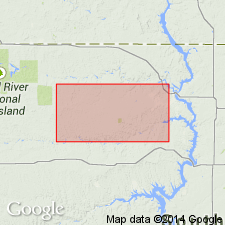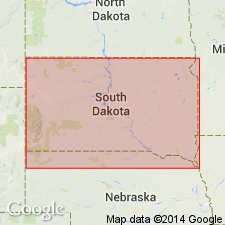
- Usage in publication:
-
- Trail City member
- Modifications:
-
- Named
- Dominant lithology:
-
- Shale
- AAPG geologic province:
-
- Williston basin
Summary:
Named as the lowest member of the Fox Hills formation (redescribed) for development around Trail City, Corson Co, SD. No type locality designated. Can be recognized for 12 mi north of Trail City along the breaks of the Grand River and for about 50 mi 25 degrees south of Trail City along the breaks of the Moreau River. Is also exposed in tributaries of the Moreau--the Little Moreau River, Red Water, Meadow, and Earth Creeks. The localities at Trail Creek and northwards are in Corson Co. The localities south of Trail Creek are in Dewey Co. The entire area is in the Williston basin. Overlies Pierre formation. Consists of brown or buff sandy shale 50 to 90 ft thick. Becomes more sandy toward top. Contains 3 to 5 locally persistent zones of fossiliferous (palecypods) gray limestone concretions that weather brown. The concretions average 1 to 2 ft in size; they may be spherical to cannonball in form; they have a core of dense limestone and often have sandy jackets. Locally in the Timber Lake area, the basal concretionary zone has black carbonaceous matter in the outer shell. Some of the black matter is black selenite gypsum speculated to be carbonized sea weed. Underlies Timber Lake member (new) of Fox Hills. Assigned to the Late Cretaceous. Columnar section.
Source: GNU records (USGS DDS-6; Denver GNULEX).

- Usage in publication:
-
- Trail City Member
- Modifications:
-
- Principal reference
- Revised
- Biostratigraphic dating
- Dominant lithology:
-
- Clay
- Silt
- Sand
- AAPG geologic province:
-
- Williston basin
Summary:
Name applied to lower member of Fox Hills Formation. Basal contact with Elk Butte Member of Pierre Shale is gradational over several ft; contact placed at obvious level of increased silt content. Silt occurs as laminae, lenses and pods that are commonly impregnated with jarosite. Extends across report area--Corson, Dewey and Ziebach Cos, SD, Williston basin. Eastern and western lithofacies named. The Little Eagle lithofacies (east) composed of fossiliferous, gray, silty to sandy shale, clayey silt, and sand, and has concretionary zones. Little Eagle: overlies Elk Butte Member; underlies Bullhead facies (formerly Bullhead Member) of newly named Iron Lightning Member of Fox Hills Formation; intertongues westward with Irish Creek lithofacies of Trail City. Irish Creek consists of sparsely fossiliferous, interbedded, interlaminated, and locally lenticular gray clay and silt; underlies Bullhead facies; overlies Elk Butte. Correlation chart; geologic map; facies map; cross sections; measured sections. Principal reference section designated in E1/2 SW1/4 sec 32, T15N, R24E, Dewey Co, where member is 98+ ft thick; overlies Elk Butte; underlies Timber Lake; consists of fossiliferous gray clayey silt, gray silty shale, one very fine grained sand, and concretions. Ammonite assemblage zones described; CUCULLANAEA Assemblage Zone near top. Of Late Cretaceous, Maestrichtian age.
Source: GNU records (USGS DDS-6; Denver GNULEX).
For more information, please contact Nancy Stamm, Geologic Names Committee Secretary.
Asterisk (*) indicates published by U.S. Geological Survey authors.
"No current usage" (†) implies that a name has been abandoned or has fallen into disuse. Former usage and, if known, replacement name given in parentheses ( ).
Slash (/) indicates name conflicts with nomenclatural guidelines (CSN, 1933; ACSN, 1961, 1970; NACSN, 1983, 2005, 2021). May be explained within brackets ([ ]).

